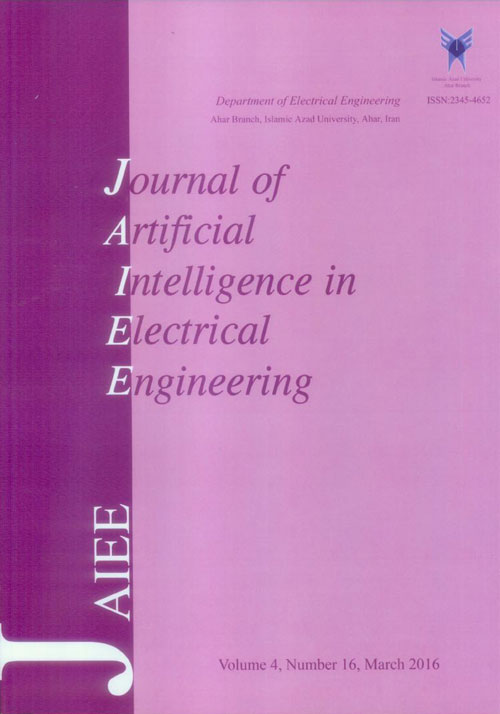فهرست مطالب

Journal of Artificial Intelligence in Electrical Engineering
Volume:4 Issue: 16, Winter 2016
- تاریخ انتشار: 1395/09/06
- تعداد عناوین: 6
-
Pages 1-8The human facial recognition is the base for all facial processing systems. In this work a basic method is presented for the reduction of detection time in fixed image with different color levels. The proposed method is the simplest approach in face spatial localization, since it doesnt require the dynamics of images and information of the color of skin in image background. In addition, to do face recognition, there is no need for the existence of image. For the extraction of facial features, the combination of knowledge-based and morphological image processing methods is utilized, which has a high accuracy, compared to other methods. The proposed method is analyzed by MATLAB software and tested on different images which demonstrated high accuracy and efficiency of the method.Keywords: Face detection, Morphological operation, Knowledge, based method, Color image
-
Pages 9-22Regarding the nature of non-linear discrete placement, and in order to determine the optimal capacity of the substation, the goal in the present study will be a number of local optimum points. In this research, the problem of optimal placement posts to reduce power losses by considering Distributed Generation (DG). In formulating the objective function, geographical distribution density in the study period and places constraints on electric posts and geographic terms were investigated. The proposed technique would be based on testing a sample network.Keywords: Substation placement, Genetic algorithm, distributed generation, Distribution system planning, radial distribution network
-
Pages 23-28In this paper, the crack detection and depth ratio estimation method are presented in beamlike structures using Elman Networks. For this purpose, by using the frequencies of modes as input, crack depth ratio of each element was detected as output. Performance of the proposed method was evaluated by using three numerical scenarios of crack for fixed-simply supported beam consisting of a single cracked, two cracked and three cracked beams have been investigated. The results indicate that the proposed method is effective in the crack detection and estimation of crack depth ratio in beam-like structures.Keywords: Crack detection, Beam, like structures, Elman Networks, Frequency
-
Pages 29-34Most accidents happens because of lack of Visibility and not Drivers reaction on time when an accident occurs. Increasing required Time for drivers reaction caused to decreasing accidents on roadways .intelligent vehicle networks brings enough time for reaction by sending alert and alternate messages to vehicles on roadway. Main propose in this paper is around modulation on Reception interval Safety message and other effective parameters on vehicles safety at CCWS applications. Effect of alert and alternate messages will be examined and modeled with Markova chain. For verification, simulation result we will used Monte Carlo method, compare result with each other, and calculated probability of collision for those vehicles that used vehicles network on roadway.Keywords: At least four key words or phrases in alphabetical order, separated by commas
-
Pages 35-44The growth in demand for electric power and the rapid increase in fuel costs, in whole of the world need to discover new energy resources for electricity production. Among of the nonconventional resources, wind and solar energy, is known as the most promising devices electricity production in the future. In this thesis, we study follows to long-term generation scheduling of power systems in the presence of wind units considering demand response programs for a power generation system with the conventional structure containing 10 units of thermal power plants, 2 units of large-scale wind farms, with regard to demand response programs. In this study, the model of equation order 2, used to model the cost of thermal power plants. Due to the apparent wind farm modeling of wind speed in the months of the year has been used the productivity of each month. For modeling the demand, response of theconcept of virtual generation demand resources is used and production costs of the final objective function are applied. All simulations, performed in MATLAB. The results showed that the cost of basic state allocated more values by itself, by considering responding load would be happened the cost reduction and the amount of this reduction changes with participation value and increases amount of lower cost by increasing participation value.Keywords: Planning production, wind farm, Imperialist Competitive Algorithm, responding load, request, resource
-
Pages 45-51Voltage profile and losses are important factors in a distribution network in which there are variety of ways to improve them. In this paper, distributed generation (DG) is used as a solution to improve the above characteristics. Backward/Forward Sweep load flow algorithm is used due to the inefficiency of usual load flow algorithms because of high R/X ratio and their lack of convergence in distribution networks. This algorithm is applied to the system and the best place to install DG is selected by Particle Swarm Optimization (PSO).Keywords: Voltage profile, distributed generation, PSO algorithm

